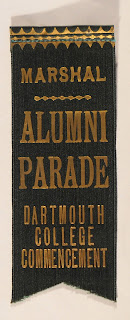 That would be Dartmouth Green not Irish Green, despite the time of year. Why Green and how was it chosen? It's a question that has been asked often over the years, and, nearly as often, has elicited a different answer.
That would be Dartmouth Green not Irish Green, despite the time of year. Why Green and how was it chosen? It's a question that has been asked often over the years, and, nearly as often, has elicited a different answer.The class of 1866 claims that they were the ones who came up with the idea of a school color and were also responsible for choosing the color green. J. E. Johnson '66, wrote a short discourse in the Bema (a student magazine) in 1917, where he made the claim on the part of his class. According to Johnson, Harvard started the idea of school colors and "passed the buck Dartmouth." A committee of the senior class (the Class of 1866) was appointed to determine a color, but they could not decide. So, they asked the two "best known and best loved young women in town": Sally Smith and Kate Sanborn, the daughter of the president and a professor respectively. The two women decided promptly on green "as being the handsomest of all colors."
Green with envy the Class of 1867 refutes this saccharin story. According to an article by Professor Bartlett published in the Dartmouth Bi-Monthly, William Ketcham, '67, claims the idea of a school color was brought to Dartmouth's attention by Amherst College. He says that Amherst came up in 1866 to teach the Dartmouth men the new game of baseball and arrived flying the College colors (purple in Amherst's case). Not having a color rankled the Dartmouth team. "Sixty-six did nothing about it, however, and it was not until '67 came to the front as the senior class that anything was done."
Frederick G. Mather, also '67, supports Ketcham's claim that it was their class who chose the color, but he has a different story about how it came about. Mather points to their classmate Alfred A. Thomas as the "originator, promoter and executor of the idea." He claims, and a Dartmouth article from the time period bears out, that Thomas attended a regatta in 1866 where Harvard and Yale turned out with school colors (crimson and blue), but Dartmouth had no color.
None of the '67s cast much light on why they chose the color green, though there is a claim that it was the only "primary" color left (we aren't exactly sure what they considered "primary," we learned it was red, yellow, and blue in our primary school). There was no talk of symbolism or meaning behind the choice.
There is less disagreement over the shade of green. And here we have evidence to turn to. In Rauner's collection is a framed ribbon that is claimed to be the original green selected at the mass meeting in (sic) the fall 1866.
So on March 17th you can wear your green whether it is for St. Patrick's Day or because you are a Dartmouth student or alum, or both.
Ask for: Vertical File: Dartmouth Green (color); and Realia 179, The Dartmouth College Color

I always thought it was picked because the deep forest green evoked the surrounding pine forests.
ReplyDeleteThis is interesting. I admit I never thought about it before now because for Dartmouth, Green seems so natural and strongly felt.
ReplyDeleteTorrey Newton '69
ReplyDeleteBig GREEN Champion of the North, strong and proud
Regarding "we aren't exactly sure what they considered "primary," we learned it was red, yellow, and blue in our primary school".
ReplyDeleteThere are two categories of primary colors:
Additive primaries, as used in electronic devices where amounts of light in each of the 3 primary colors are added together
Subtractive primaries, as used in printed matter where amounts of light are absorbed by ink that filters out (subtracts) each of the 3 primary colors from white light (also in printing black is included as a "fourth primary").
The 3 additive primaries are: red, green, blue, e.g., what you'll see if you look closely at your CRT or LCD TV or computer monitor screen.
The 3 subtractive primaries are: cyan, magenta, yellow, e.g., like the colors of the ink cartridges you buy for you computer printer.
http://en.wikipedia.org/wiki/Primary_color